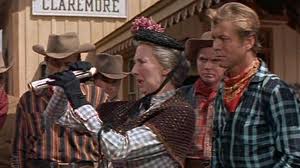As the U.S. added Western territories, they were administered by the Federal Government. For example, the marshal who arrests Curly is a federal official. The territories would petition to be admitted to the Union as states. Oklahoma territory became the 46th state in 1907. This movie takes place just before that time. Will Parker has just been to Kansas City. He remarks, in the song, about how “Everythin’s up to date in Kansas City.” This song tells a lot about what is happening in the U.S. at the time of this movie:
“They went and built a sky scraper seven stories high. About as high as a buildin’ orta grow.”
Until the perfection of the elevator in the 1890s, seven stories was about as high as a building could go. Most people can’t climb more than seven flights of stairs at one time. The first skyscraper was built in 1895 (Louis Sullivan’s Guaranty Building, Buffalo, N.Y.) It took time for real skyscrapers to be built in Oklahoma.
“I counted 20 gas buggies goin’ by theirselves, almost ev’ry time I tuck a walk.”
The automobile was becoming common in the first decade of the 20th century. According to the song, there were very few in rural Oklahoma.
“[Then] I put my ear to a Bell telephone and a strange woman started in to talk.”
The telephone was invented by Alexander Graham Bell in 1879 but, apparently, had not made it to rural Oklahoma by the time of this song.
“Y’ c’n turn the radiator on whenever you want some heat. With ev’ry kind o’ comfort ev’ry house is all complete. You c’n walk to privies in the rain and never wet your feet! They’ve gone about as fur as they c’n go.”
Indoor plumbing was rare in rural areas of the Territory of Oklahoma.
In the frontier areas, peddlers brought goods to the farmers. They were often distrusted by the farmers, especially when the peddlers were recent immigrants.
In the states on the Great Plains there was tension between ranchers who needed free unfenced range to run their cattle and farmers who erected fences to protect their crops from wandering animals.



